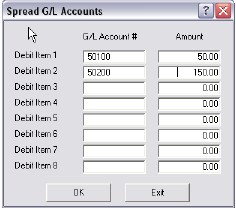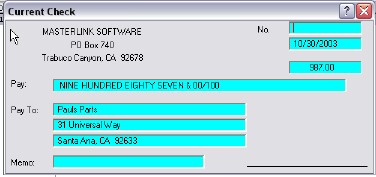Transactions are the activities that take place which affect the balances of your Accounts Payable. Whenever a sublet is obtained, or parts received on credit, the item is marked. When that system runs its Daily Closing, transaction tickets are written, and posted to the transaction file in The Accountant. These tickets are individualized for each activity, and account.
Payments, and non-invoice charges, must be entered. Once the Post option of the Payment Menu is selected, the system will ask for an account number. If a number is entered, the system will display a data input screen. The following information, and procedures, are provided:

Vendor Data
The system will display the vendor information, including the name, address, phone numbers, and account number. Be sure to verify that your posting is for the correct vendor.
Pending Credits
The system will show you any pending credits that you have available on this account.
Balance Due
This field will be the system display of your current balance due on the account. The system takes your current total of open invoices and subtracts your pending credits to arrive at the amount.
Date
Although the current date is automatically entered, you may enter a new date to match when the transaction has, or will, actually take place.
Cash Payment
If you made a payment in cash, point at this box and press the left mouse button to enter a check mark.
* Note * You will want to use this field to note an invoice number, or statement ID, received from the vendor.
Charge
If you are posting an amount for which you have been billed, it goes in the charge field. Many parts of The Auto Shop Writer ( ie. Stock Input ) automatically post charges to an account, so you do not need to repost them at this point.
Payment
If you wish to make a payment to a vendor, enter the amount you wish to pay in this field. If you are not sure how much you owe, look at the balance due field.
Debits/Credits
Your system will provide default account numbers for the Debits and Credits on both charges and payments. However you can change those numbers if you wisht to post the transaction to a different account.
Transaction Listing
The transaction listing field displays the open invoices currently in the system. It shows the original amount, the current balance due, and provides a space for posting the amount you paying against the balance.
Available Funds
This amount is the combination of pending credits, and the payment amount that has been entered. This will be reduced by any monies applied to individual invoices as explained in the next section.
Applying payments
To apply funds ( payment amount plus credits, as displayed in the Available Funds field ), simply point to an invoice with a balance and right click on the mouse button. A popup screen will ask for the amount to be applied.

An amount will be shown by default. If there are sufficient available funds, the number will be the total balance due on the invoice. If there are less funds available than the balance due, the number will be the total available. In either case, you can change this amount if you wish, except that you cannot apply more funds than you have available. By selecting ![]() , the amount will be applied.
, the amount will be applied.
If you apply too much to one invoice, and wish to apply some of the money to another entry, simply re-select the invoice you wish to reduce, and right click on the entry. The system will pop up a box with the amount you originally intended to pay, and you can modify the amount as you wish, then save it.
You can work with all items, and adjust them as you desire, until you have used the total available funds.
Once you complete applying funds, press the ![]() button to actually process the work.
button to actually process the work.
Add
Once you complete a transaction, you can post another transaction by selecting the ![]() button. The system will ask for the account number of the new transaction. Although the existing number is displayed, if you start typing a new number, the old value will be immediately erased.
button. The system will ask for the account number of the new transaction. Although the existing number is displayed, if you start typing a new number, the old value will be immediately erased.
Spread G/L

When posting a charge, it will be important to debit an expense account. In some cases, it is necessary to spread the total amount across multiple expense accounts. This button will pop up a window that details how much money is to be applied, and allows you to select multiple G/L accounts, and specify the amounts to be applied to each.
Stub Detail

Although the system automatically generates information for the check stub, it is possible to add, or edit, the information by selecting the Stub Detail option. A popup window will display that allows you to view, and edit, the text.
View / Print Check

If you are making a payment, you can select the View Check button to see what the check will look like that is to be printed. In view mode, you can then select the button to Print the check immediately.
OK
You must select the![]() button after you enter the payment information, and apply any payment transactions to open invoices.
button after you enter the payment information, and apply any payment transactions to open invoices.
Close
Select the ![]() button when you have finished processing Accounts Payable transactions.
button when you have finished processing Accounts Payable transactions.
Payment Hold
Often an order is delivered, and a check is required, prior to entering the order into the system. Now checks may be issued, and placed on hold, to be processed against a specific Purchase Order.
Select the Bank - Write a Check option, and then enter the invoice number in the Reference field, and the Payment amount. You will be asked to Process or Hold the entry. Enter an H in the available box, and the system will flag this item to be applied when processing the purchase order.
When you proceed to enter the parts and totals on the Purchase Order, the system will seek, and display all held checks for this accunt number. You may highlight, and select, the proper item, and all accouting will then take place as it should, posting both the charge and payment, and processing the check.